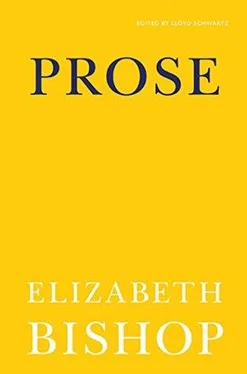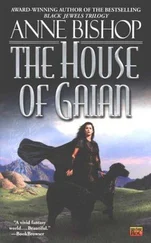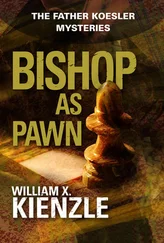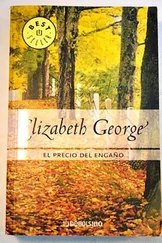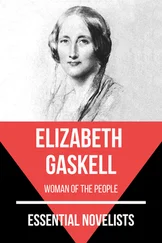Diamonds and gold, but chiefly diamonds, still obsess the economy. The hotel manager (a new hotel, designed by Oscar Niemeyer, was finished in 1956), using almost the very words that Helena used in 1893, complained that he had to fly in vegetables from Belo Horizonte. “Here no one’s interested in anything but gold and diamonds,” he said. “They say they can’t grow vegetables in this soil, but it isn’t true. They think of nothing but diamonds, diamonds, diamonds.” It is strange to see, on the side of a miserable little house, a blue and white enamelled sign announcing that here is a diamond dealer. I looked inside one of these houses and could see nothing but overhead a lurid plaster statue of St. George killing the dragon, with a small red electric light bulb glowing in front of it, and under it, on the table, a bunch of live-forevers and a fine pair of scales in a glass case. The scales are covered up at night, like the innumerable caged birds hanging everywhere. Curiously shaped stones, lumps of ores, clusters and chunks of rock crystal and quartzes are everywhere, too, used as door-stops and sideboard decorations. In the cold clear air, the town itself, with its neatness, rockiness, and fine glitter, seems almost on the point of precipitation and crystallization.
In the recently opened museum there are the usual polychrome saints and angels, sedan chairs and marriage beds, and then suddenly and horribly an alcove hung with the souvenirs of slavery: rusty chains, hand-cuffs, and leg- and neck-irons draped on the wall; pointed iron prods originally fastened to poles; and worse things. Driving about the region, the sites of the old slave encampments are pointed out. Trees, and a very fine short grass, supposedly from Africa, distinguish them, and they are usually beside a stream and near the pits of old mines. But now there is only the small Negro and mulatto population to show for all the million or more slaves who came here in the eighteenth and early nineteenth centuries.
I made an excursion to Boa Vista, where Helena’s father mined. The mines are abandoned now, although they were worked on a large scale by foreign companies up until a few years ago. There is nothing to be seen but an immense excavation exposing soils of different colors (each with a different name; Burton’s book gives an excellent account of them and the different methods of mining), and endless iron pipes. Boa Vista is slightly higher than Diamantina; although it is six or seven miles away one can see a church-tower. The road there is dirt, narrow, winding, and eventually the taxi scrapes over outcroppings of naked rock and splashes through streams. Battalions of grotesque rocks charge across the fields, or stand like architecture, pierced by Gothic-ruin windows. Large slabs balance on top of moldering turrets, with vines, bushes, and even stunted palm-trees on their tops. Helena Morley was not a fanciful child but I wondered at her riding on her borrowed horse, before sun-up, along this nightmare road, hurrying to get back to Diamantina in time for school.
I took with me a life-long friend of Helena’s future husband, Dr. Brant, Senhor Antonio Cicero de Menezes, former local director of the Post Office service, now eighty years old, a very distinguished-looking man with a white Vandyke beard and moustaches, like an older, frailer Joseph Conrad. We came back through the hamlet of twenty or so houses that is Palha (straw) today and Seu Antonio Cicero said, in Helena’s very phrase, “Now let us descend and suck fruit.” So we sat in the tiny general store, surrounded by household and mining necessities: iron kettles and frying pans, salt beef and soap, and sucked a good many slightly sour oranges. A little boy brought them in a gold-panning bowl and Seu Antonio Cicero prepared them for me with his pocket-knife faster than I could suck. The storekeeper showed me a store room full of these wooden bowls, cowhides and tarry lumps of brown sugar and sieves for panning diamonds, piled on the floor, and boxes and boxes of dusty rock crystals, bound, he said, for the United States, for industrial purposes.
Near there we stopped again to watch a group of men looking for diamonds in a stream beside the road. The head of the group had four men, black and white, working for him; he gave me his name and asked me to print it; here it is: Manoel Benicio de Loyola, “diamond-hunter of Curralinho.” They were shovelling in the shallow, sparkling water, damming it up, releasing it, and arranging piles of gravel on the bank. One of them took up a small quantity of gravel in the wide round sieve and held it just beneath the surface of the water, swirling it skilfully around and around. In a few minutes he lifted it out; the gravel was distributed evenly over the sieve in one thin layer. With the gesture of a quick-fingered housewife turning out a cake, he turned the whole thing upside down on the ground, intact. Senhor Benicio de Loyola then put on his horn-rimmed glasses, lowered himself to his knees in the wet mud, and stared, passing a long wooden knife over the gravel from side to side. In a second he waved his hand, got up and put his glasses back in his pocket, and his assistant got ready to turn out another big gravel pancake, while he and Seu Antonio Cicero talked about a large blue diamond someone had found somewhere a day or two before.
This is the simplest of all forms of diamond “mining.” It goes on all around Diamantina constantly, and enough diamonds are found in this way to provide a meagre living for some thousands of people. One sees them, sometimes all alone, sometimes in groups of three or four, standing in every stream. Sometimes they are holding a sieve just under the water, looking for diamonds, sometimes they are sloshing their wooden bowls from side to side in the air, looking for gold. The bent heads and concentration of these figures, in that vast, rock-studded, crucifix-stuck space, give a touch of dementia to the landscape.
I also made an excursion to Biribiri (accented on the second and last “i”s), an enchanting spot, where Helena used to dance, and leap through St. John’s Day bonfires. The factory, for weaving cotton, is still there, but nothing could look less like industrialization. One descends to a fair-sized river and the landscape is green and lush; there are many trees, and fruit trees around the blue- or white-washed stone houses along the one unpaved street. In the middle is the church, better kept up than any of the others I saw, trim, almost dainty. Indeed, it looks like an old-fashioned chocolate box. A blue picket fence encloses the flourishing flower-garden and over the door, below the twin towers, is a large rounded pink Sacred Heart with a crown of realistic ten-inch thorns, green wooden palm branches and blue wooden ribbons. Close around the church stand a dozen real palms, Royal palms, enormously tall and slender, their shining heads waving in the late afternoon sun.
“Helena Morley”
In one of his letters to Robert Bridges, Hopkins says that he has bought some books, among them Dana’s Two Years Before the Mast, “a thoroughly good one and all true, but bristling with technicality — seamanship — which I most carefully go over and even enjoy but cannot understand; there are other things, though, as a flogging, which is terrible and instructive and it happened —ah, that is the charm and the main point.” And that, I think, is “the charm and the main point” of Minha Vida de Menina. Its “technicalities,” diamond digging, say, scarcely “bristle,” and its three years in Diamantina are relatively tame and unfocussed, although there are incidents of comparable but casual, small-town cruelty. But— it really happened; everything did take place, day by day, minute by minute, once and only once, just the way Helena says it did. There really was a grandmother, Dona Teodora, a stout, charitable old lady who walked with a cane and managed her family and her freed slaves with an iron will. There really was a Siá Ritinha who stole her neighbors’ chickens, but not Helena’s mother’s chickens; a Father Neves; a spinster English Aunt Madge, bravely keeping up her standards and eking out a living by teaching small obstreperous Negroes, in a town financially ruined by the emancipation of the slaves and the opening of the Kimberley diamond mines.
Читать дальше
